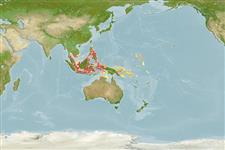Classification / Names
Nombres comunes | Sinónimos | Catalog of Fishes(Género, Especie) | ITIS | CoL | WoRMS | Cloffa
>
Ovalentaria/misc (Various families in series Ovalentaria) >
Pomacentridae (Damselfishes) > Pomacentrinae
Etymology: Pomacentrus: Greek, poma, -atos = cover, operculum + Greek, kentron = sting (Ref. 45335); cheraphilus: Named for its predilection for silty habitats; name from Greek meaning silt lover.
Environment: milieu / climate zone / depth range / distribution range
Ecología
marino asociado a arrecife; rango de profundidad 10 - 18 m (Ref. 86257). Tropical
Western Pacific: Brunei and the Philippines.
Tamaño / Peso / Age
Maturity: Lm ? range ? - ? cm
Max length : 6.1 cm SL macho / no sexado; (Ref. 86257)
Short description
Claves de identificación | Morfología | Morfometría
Espinas dorsales (total) : 13; Radios blandos dorsales (total) : 13 - 14; Radios blandos anales: 13 - 15. This species is distinguished by this set of characters: D XIII, 13-14; A 13-15; pectoral rays 17-18; tubed lateral-line scales 17-19; total gill rakers on the first branchial arch 19-21; yellow juvenile phase with blue stripes on the upper head and adjacent anterodorsal portion of the body; light grey to dark greyish brown adult phase with a dark-edged greenish spot just below lateral line origin (Ref. 86257).
Adults inhabit silty reefs around coral and rock outcrops (Ref. 86257). Oviparous, distinct pairing during breeding (Ref. 205). Eggs are demersal and adhere to the substrate (Ref. 205). Males guard and aerate the eggs (Ref. 205).
Life cycle and mating behavior
Madurez | Reproducción | Puesta | Huevos | Fecundidad | Larva
Oviparous, distinct pairing during breeding (Ref. 205). Eggs are demersal and adhere to the substrate (Ref. 205). Males guard and aerate the eggs (Ref. 205).
Allen, G.R., M.V. Erdmann and V.V. Hilomen, 2011. A new species of damselfish (Pomacentrus:Pomacentridae) from Brunei and the Philippines. aqua, Int. J. Ichthyol. 17(1):35-42. (Ref. 86257)
IUCN Red List Status (Ref. 130435: Version 2024-1)
Threat to humans
Harmless
Human uses
Herramientas
Special reports
Download XML
Fuentes de Internet
Estimates based on models
Preferred temperature (Ref.
123201): 28.5 - 29.2, mean 28.9 °C (based on 662 cells).
Phylogenetic diversity index (Ref.
82804): PD
50 = 0.5000 [Uniqueness, from 0.5 = low to 2.0 = high].
Bayesian length-weight: a=0.02455 (0.01155 - 0.05216), b=2.98 (2.81 - 3.15), in cm total length, based on LWR estimates for this Genus-body shape (Ref.
93245).
Nivel trófico (Ref.
69278): 2.7 ±0.3 se; based on size and trophs of closest relatives
Resiliencia (Ref.
120179): Alto, población duplicada en un tiempo mínimo inferior a 15 meses (Preliminary K or Fecundity.).
Fishing Vulnerability (Ref.
59153): Low vulnerability (10 of 100).
